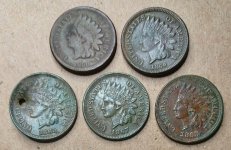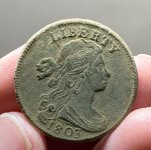M.E.G.
Sr. Member
- Apr 25, 2014
- 498
- 875
- Primary Interest:
- All Treasure Hunting
BLM records list the status of granted valuable mineral deposits as an administrative entries, i.e., leaseable mineral or saleable mineral, under the 1976 FLPMA.
So be ready for some trouble from the agencies over your claims, whether or not you use defective premade forms.
Most store-bought or provided forms that are filed as location notices have problems.
And each is different.
What you are filing is a Location Notice. The importance of this document can not be understated. The location notice is the evidence and title to the land claimed. Being title to the land claimed it is extremely important to state things correctly.
What store-bought forms do and what you have to avoid in the Notice is accepting obligations that are not part of the grant or anticipate entry under the 1976 FLPMA. Phrases such as "subject to state law" are tell-tale problems because there is no such requirement under the grant. There are state statutes but those must conform to the "laws of the United Sates" and really only pertain to how one establishes possessory title and exclusive possession under the mining law, 30 USC 26. The 1866 act is a law of the United States and congressional land disposal act and no state or agency can intefere. It was amended in 1870 to include placer deposits and again in 1872 to include all valuable mineral deposits, not merely those minerals expressed under the 1866 Act. This is not so for administrative entries. "mining claims" such as for Common Mineral Materials, 30 USC 612. The current "book store" forms appear inadequate for the specific purpose of the Mineral Estate Grantee.
You are not just making a "mineral claim". You are claiming a mineral deposit. There is a big difference, even though they all go through the formal requirements for making a claim guided by the 1872 Act.
The Location Notice is a notice of exclusive Claim of a mineral deposit which enjoys "as patent" rights. As such, by this you can readily see any obligation you volunteer in your Notice gives the Notice that you will accept a lesser estate subject to external or state or federal statutes or rules. Such a claim is not "as patent" and is subject to state and federal regulation, such as environmental impositions, bonds and reclamation.
You could take a Bookstore form as a model and then cut out all the servitudes, then add a couple lines accepting your mineral deposit located and granted in the Act of July 26, 1866.. . as amended by the Act of 1870, if for a placer deposit, pursuant to the Act of 1872.
You can get a copy of the 1866 Act at Our Backyard and look at The Law page. Print out HR 365 and the Hicks case for reference material to carry with you. The first paragraph of HR 365 has most of what you need for a Location Notice statement. You'll need to add the Legal Description describing or segregating the land to the notice. ..and the other requirements.
I don't want to make it sound complicated because it really isn't. The requirement though to stay true to the act of 1866 or as amended as the case may need, is required. The mineral disposal Acts are a simple but have far-reaching consequences which we enjoy today. Such as RIGHT of way access in Section 8. This means, if you are prospecting you have right to be in the public land and on the roads. Read the Hicks case for clarification. Notice he was on a "closed" road and had right to be there.
There is an open invitation every First Friday to the SWOMA meeting. Jefferson Mining District meeting to follow. We always go over a lot of stuff and people can get help too. A lot of help is on the fly but it seems to work out.
So be ready for some trouble from the agencies over your claims, whether or not you use defective premade forms.
Most store-bought or provided forms that are filed as location notices have problems.
And each is different.
What you are filing is a Location Notice. The importance of this document can not be understated. The location notice is the evidence and title to the land claimed. Being title to the land claimed it is extremely important to state things correctly.
What store-bought forms do and what you have to avoid in the Notice is accepting obligations that are not part of the grant or anticipate entry under the 1976 FLPMA. Phrases such as "subject to state law" are tell-tale problems because there is no such requirement under the grant. There are state statutes but those must conform to the "laws of the United Sates" and really only pertain to how one establishes possessory title and exclusive possession under the mining law, 30 USC 26. The 1866 act is a law of the United States and congressional land disposal act and no state or agency can intefere. It was amended in 1870 to include placer deposits and again in 1872 to include all valuable mineral deposits, not merely those minerals expressed under the 1866 Act. This is not so for administrative entries. "mining claims" such as for Common Mineral Materials, 30 USC 612. The current "book store" forms appear inadequate for the specific purpose of the Mineral Estate Grantee.
You are not just making a "mineral claim". You are claiming a mineral deposit. There is a big difference, even though they all go through the formal requirements for making a claim guided by the 1872 Act.
The Location Notice is a notice of exclusive Claim of a mineral deposit which enjoys "as patent" rights. As such, by this you can readily see any obligation you volunteer in your Notice gives the Notice that you will accept a lesser estate subject to external or state or federal statutes or rules. Such a claim is not "as patent" and is subject to state and federal regulation, such as environmental impositions, bonds and reclamation.
You could take a Bookstore form as a model and then cut out all the servitudes, then add a couple lines accepting your mineral deposit located and granted in the Act of July 26, 1866.. . as amended by the Act of 1870, if for a placer deposit, pursuant to the Act of 1872.
You can get a copy of the 1866 Act at Our Backyard and look at The Law page. Print out HR 365 and the Hicks case for reference material to carry with you. The first paragraph of HR 365 has most of what you need for a Location Notice statement. You'll need to add the Legal Description describing or segregating the land to the notice. ..and the other requirements.
I don't want to make it sound complicated because it really isn't. The requirement though to stay true to the act of 1866 or as amended as the case may need, is required. The mineral disposal Acts are a simple but have far-reaching consequences which we enjoy today. Such as RIGHT of way access in Section 8. This means, if you are prospecting you have right to be in the public land and on the roads. Read the Hicks case for clarification. Notice he was on a "closed" road and had right to be there.
There is an open invitation every First Friday to the SWOMA meeting. Jefferson Mining District meeting to follow. We always go over a lot of stuff and people can get help too. A lot of help is on the fly but it seems to work out.
Amazon Forum Fav 👍
Upvote
0









